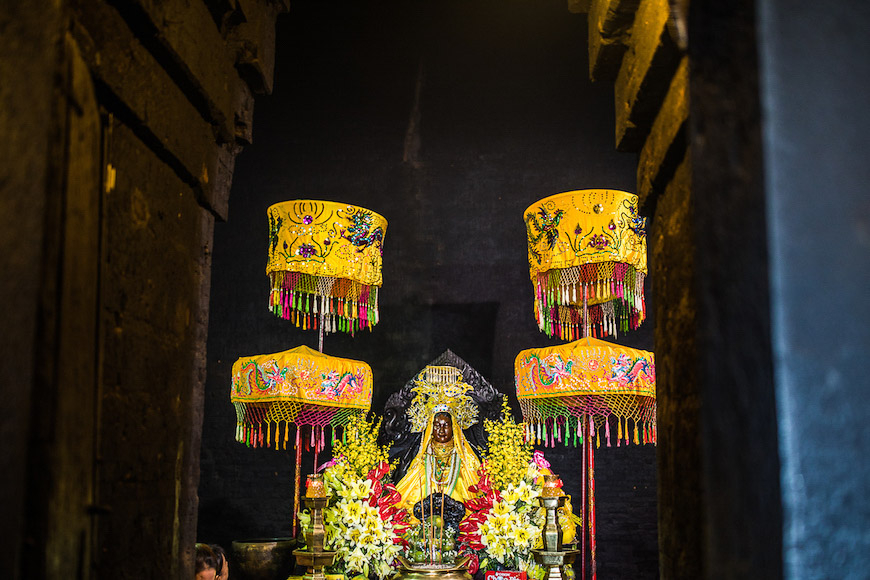Such was the artistry of ancient Cham architects and artisans that their temples and stone carvings are some of the most moving relics found in Southeast Asia today. Discover the awe-inspiring art and architecture of the ancient Kingdom of Champa.
Six kilometres west of Phan Rang town in Central Vietnam lies a low hill topped by three mysterious brick temple-towers known as Po Klong Garai. Climbing over rocky ground dotted with cacti, you will reach the 13th century shrines, a legacy of the Kingdom of Champa, a powerful Indianised culture that flourished in South-Central Vietnam from the 4th to 13th centuries. Gazing at the arid landscape below and the jagged red brick towers overhead, it’s impossible not to feel the magic of this sacred site.

Given their coastal location, the Chams were a seafaring culture. At its peak, the Champa Kingdom controlled the trade in spices and silk between China, India, Indonesia, and Persia. Highly cosmopolitan, this culture was heavily influenced by Hindu beliefs adopted from India. Many of their shrines honour Shiva--often shown as a linga, while their carvings depict all manner of Hindu deities. Hindu doctrines were blended with homegrown beliefs, such as their conviction that they were descended from a goddess named Po Nagar, born from heavenly clouds and sea foam. Also known as the Mother of the World, she created the earth, trees and rice and taught people how to live off the land.

On Mount Cù Lao in the central beach resort of Nha Trang lie the Po Nagar Towers, a complex of temple-towers overlooking city streets and the sparkling blue bay beyond. Surrounded by red-flowered flame trees, the four remaining towers date from the 7th to 12th centuries but this site has been considered sacred for much longer. The central tower is devoted to the Goddess Po Nagar, who is portrayed as a cross-legged statue with ten arms. Surrounded by the bustle of the city, these Cham towers provide a fascinating glimpse into the region’s past and the locals’ present-day spiritual beliefs as pilgrims still come here to pray and offer incense. Each year, from the 21st to 23rd days of the Third Lunar Month (17th to 19th April, 2017), a colourful festival unfolds here to honour Po Nagar. Ethnic Cham people gather to bathe and dress the Goddess’ statue and perform prayers and sacred dances.

Around 50 remaining Cham towers are dotted all over Central Vietnam. Bình Định province boasts 14 sites, including the Po Shanu Towers near Phan Thiết. Other noteworthy towers include Nhan Tower in Phú Yên province; Po Dam in Bình Thuận province; and Yang Prong Cham Tower in the Central Highland province of Đắk Lắk. The undisputed highlight for those with an interest in Cham architecture is the UNESCO-World Heritage site of Mỹ Sơn, located in present-day Quảng Nam province.

In 1889, while overseeing the construction of a telegraph line in Central Vietnam, a Frenchman by the name of Camille Paris stumbled upon the crumbling ruins of Mỹ Sơn - the onetime religious capital of the Champa Kingdom long forgotten by the wider world. Decades of research revealed the existence of 70 temples. Sadly, this site was devastated by B52 bombing in 1969 and 1972. Today, many structures have been painstakingly restored, giving visitors a glimpse into the spiritual lives of the ancient Chams, whose political capital Simphaparu (now Trà Kiệu) lay 10km from Mỹ Sơn.

Perhaps the easiest way to experience the Chams’ artistic magic is by visiting the Museum of Cham Sculpture in Đà Nẵng. Opened in 1919, this museum encompasses lush grounds, a charming French-colonial building and a new wing that house the world’s largest collection of Cham art. Collected from sites in Quảng Nam and beyond, the museum displays around 300 priceless sandstone and terra-cotta sculptures. While the Kingdom of Champa is ancient history, their vividly carved stone deities, sacred animals and dancing girls still evoke the same feelings of awe and delight they inspired centuries ago.




